100k users, 200% revenue increase: Inside Bumpa's Growth Playbook
A masterclass in user psychology, growth experimentation, and product marketing.
Hi there.
Welcome to the 280 new subscribers who joined Marketing For Geeks since the last issue. Big thanks to everyone who shares MFG with their network.
ICYMI: In my last issue, I shared some noteworthy Children’s Day messaging from Nigerian brands.
Today is for Funnel Vision, where I write a case study on a campaign, project, or product by speaking with the marketing professional behind them.
In this issue, I look into Bumpa’s growth story with Precious O’Dahunsi, Product Growth Manager at Bumpa.
What To Expect:
Bumpa’s early days
Product marketing at Bumpa
Feature adoption tactics
Improving user onboarding & activation
Working with engineers as a non-technical person
The first time I encountered Precious O’Dahunsi, she was teaching a free product marketing webinar for Treford. I was a content marketer; she was a product marketer who’d transitioned from content marketing. After her class, I decided to transition into product marketing too.
3 years later, my career path has mirrored Precious’ eerily. She went from content marketer to product marketer to product manager to product growth manager. I followed almost the exact trajectory.
But my career growth happened across different companies; Precious had grown within the same company she was growing. Precious O’Dahunsi was Bumpa’s first full-time marketing hire; today, she leads a product growth team to solve activation, retention, monetisation, and growth problems for Bumpa.
If I were to scour the earth, I would not find a person more qualified to tell Bumpa’s growth story than Precious. So, I reached out and we spent 2 hours breaking down Bumpa’s growth playbook.
Bumpa’s Early Marketing
At least 32% of e-commerce in Sub-Saharan Africa takes place through social platforms like Facebook, WhatsApp, and Instagram1. But these platforms weren’t built for e-commerce, which means they don’t truly enable success. That’s where products like Bumpa come in.
In Bumpa’s early days, customers would often mistake Bumpa for a marketplace—one that could help them find new customers. This is because before Bumpa, their only experience was on social platforms with in-built distribution. But Bumpa is not a marketplace. It doesn’t connect you to new customers; it only enables you to manage their experiences and your operations better.
This distinction is critical, because it was one of the early problems Precious had to battle in Bumpa. She was marketing to people whose previous experiences were with distribution channels.
“When we first started, some people came with the notion that we’re a marketplace like Jumia. Then, I used to liken Bumpa to Instagram cos that’s what they could relate to. You don’t join Instagram and expect to automatically get followers. You have to create content, push ads, and engage with people. So, [I said] Bumpa is a tool that’ll work amazingly for you if you put in the work. But you can’t sit down and expect it to bring sales.”
Bumpa never directly positioned as a marketplace, but people misinterpreted their messaging to mean so. For example, Bumpa used to use the tagline “The easiest way to sell online,” which people misinterpreted to mean that Bumpa would help increase sales (presumably by exposing them to more users).
“We didn’t position as a marketplace, but people interpreted it that way because of a preconceived understanding of certain words. Copy like ‘make sales everywhere’ or ‘the easiest way to sell online’ used to attract a certain kind of user. It attracted lazy users and brought unique retention problems.”
After this, Precious learnt to steer clear of any messaging that could be misinterpreted.
She might not have realised it at the time, but this was product marketing work. Even though she was a content marketer at the time, Precious unofficially laid the groundwork for Bumpa’s messaging.
A year later, Precious had to fight for this messaging, and she learned an important lesson about documentation. Because she had never documented this insight, a new growth marketer joined the company and advised a switch in messaging.
“It’s because there was no documentation saying ‘don’t do this, don’t do that.’ We didn’t have it [the messaging insight] documented, but it was commonly understood [in the early days].”
Because the initial experiment wasn’t documented, the marketing team had to try the flawed messaging again, only to come to the same conclusion as before. After this experience, Precious became more gung-ho about documentation and cross-team communication.
“After that discussion, I realised we needed to document more to ensure whoever comes after us follows these guidelines. I was already in the product team at this time, so I set up a weekly sync conversation between myself and the marketing team.”
In engineering, there is a term for a senior-level technical expert who plays a critical role in setting technical direction, solving complex engineering problems, and often mentoring other engineers. This person is typically a long-timer who can explain why core systems are the way they are and who protects the long-term health of the codebase.
As Precious speaks, I can’t help but wonder if this concept also applies to marketing. And if product marketers are, in some ways, the “principal marketers” in organisations. Certainly, the term “Principal Marketer” would be an apt description of what Precious’ role has evolved to become, even as she pivoted from marketing to product.
I have started this story from the middle. But to understand why Precious often acts as a principal marketer, I need to start at the beginning.
Day 1-7 At Bumpa
In ideal scenarios, a new hire would spend the first week familiarising themselves with their new role & organisation. But when Precious officially joined Bumpa, she was already familiar with it, having done some contract work for them previously, including writing scripts for paid ads.
And so, when Precious began executing on her first day, it made perfect sense. Bumpa wasn’t new to her; she wasn’t new to it. And she’d worked with Bumpa’s CEO months beforehand, writing for his other project, Consonance Club.
On Precious’s first day, she created the Gift From Bumpa brand persona and wrote their first set of articles.
Gift From Bumpa - Defining Bumpa’s Brand Persona
By the end of Week 1, Precious had built the groundwork for Bumpa’s brand persona. She tells me the story of how the name came to be.
“They wanted to create an official email for me and there was already a Precious in the company. I knew that this email would be used to send out marketing content for the company and become part of the brand. So I first thought it should be a “B” name, like Bimbo, Bolanle, Bernice. But I decided to use my name; or one of my names that I hadn’t really used.”
When Precious chose the name “Gift from Bumpa,” she did not realise that it would provide an unexpected advantage for their emails. Bumpa’s newsletter got great open rates because customers would read “Gift from Bumpa” and think that they had received a gift from the Bumpa team.
Apart from choosing the name, Gift defined Bumpa’s brand persona. She wanted a consistent persona that people could relate to. Something that was casual without being too informal. Unconsciously, she built the persona to reflect her own voice. Finally, she coined Bumpa’s “your business best friend” tagline.
All of her work paid off. Customers began to get attached to the brand. In fact, a customer once wrote to “Gift from Bumpa” that her emails were uplifting.
“I mean, I put my personality into the newsletter, but I had no idea that for some people, it was uplifting. It was heartwarming and part of the excitement. I no longer write the weekly newsletters, but I still remember that.”
Day 8-31
Precious’ first few days were off to such a strong start, so I ask what the first month was like. She tells me that it wasn’t always execution; they also talked a lot.
“We used to do a lot of long standups at the time. The entire company could fit into one stand-up then, so we used to do that every single day. Engineering would talk, marketing would talk.”
Email marketing was one of Bumpa’s early acquisition channels. So Precious spent her first month sending cold emails to a list of SMEs across different demographics, with the help of a contract marketer. This was separate from the engagement emails she would send to users.
These cold emails, as well as some community marketing, exposed Bumpa to a new demographic and expanded its user base.
Day 32-365
Three months into the year, Bumpa had seen a 792% increase in its user base. Their efforts were bearing fruits.
There were direct and indirect drivers of this growth. The biggest indirect driver was the personal brands of Precious and of Bumpa’s CEO. They had become marketing channels for Bumpa. It wasn’t planned; they never set posting guidelines. They just loved posting about the product (and what work at Bumpa was like). It didn’t take long for people to associate them with the brand.
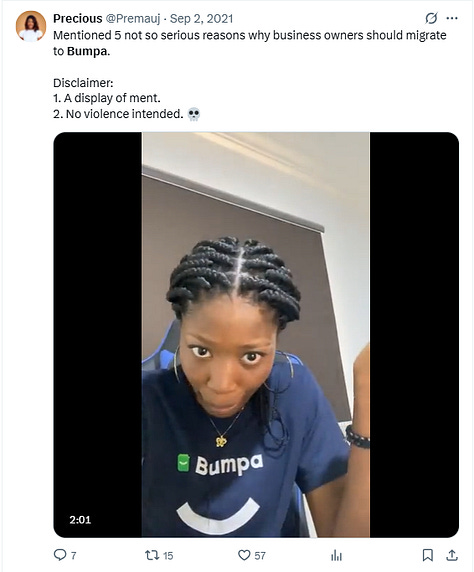
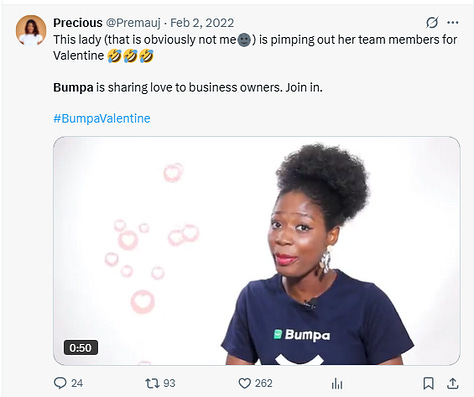

Posting on her account wasn’t part of Precious’ job description. But doing things outside her job description wasn’t strange to her. Throughout the year, she handled varied tasks. Whatever needed to get done that she could do.
“I became a UX writer. We made some UX changes and I’d contributed to things like error messages across the app. I also did mini GTMs here and there to launch new products. There was a lot of copywriting for designs going on socials or ads. And then SEO articles to get traffic.”
At this point, Precious’s job title was just “Content Marketer.” But—as is typical with early-stage startups—everyone on the team had to work on the margins. The customer support person was doing a little product work. The product designer was also a product manager. The CTO, an introvert by nature, was conscripted to act in video ads. The CEO had his hands in multiple pies.
But it paid off. By the end of the year, they’d hired 2 new marketing team members, organised a physical event, and even put up a billboard. They’d worked with influencers like KieKie. They were running steady ads on Facebook and Google. They’d grown. Bumpa could no longer fit on a single standup.
Product Marketing at Bumpa
Precious was doing product marketing before she knew what product marketing was. When she was a Content Marketing Manager, she’d defined product messaging and planned GTM. So when I ask her about the difference between content & product marketing, I am not surprised at her answer.
“There’s a funny belief I have that might be peculiar to me and Bumpa. I feel like product marketing is content marketing on steroids. It’s content marketing with ridiculous amounts of data, focus, and technicality. For me, I think everything is content marketing in some regard.”
Precious explains what she means by focus. Content marketers typically have to do marketing for the entire product. They look at the product as a bundle. But with product marketing, the product is a sum of its various functionalities. And sometimes, product marketers focus on one specific functionality at a time.
“Content marketing was very widespread. But with product marketing, the conversation could be ‘this week, we’ve not seen a lot of traction for this new feature we launched.’ And then we identify the problem. What does the usage data say? What are the drop-off points? Maybe based on that, we do a survey. Based on that, we start thinking of solutions. Maybe something on social media, maybe a UI change, and so on.”
Some tasks often overlap between product & content marketing, like how-to articles. When Precious was a content marketer, she had written how-to articles for specific features on Bumpa. But her approach was straightforward. Step 1, 2, 3, CTA. As a product marketer, she faced how-to articles again. But this time, her approach was different. She wrote articles with a deeper understanding of each functionality on its own and as a part of Bumpa.
“For example, if someone wants to learn how to record sales on Bumpa, I’m not going to tell you ‘open your app, do this, do that.’ I’ll also include what other features or functionalities are attached it [that could increase the value to you]. So, in that one article, you’ll learn how recording sales impacts the analytics you have every month on Bumpa. I’ll link it to how recording sales means you get receipts and invoices automatically. I’ll talk about benefits of using it to apply for grants.”
Another difference, says Precious, is that content marketing campaigns were very public-facing while product marketing tasks are often only pushed to users. Rather than working with influencers or pushing ad campaigns, Precious was working on onboarding new users and improving adoption.
Bumpa Wrapped
Precious tells me that one of the product marketing projects she had fun working on was Bumpa Wrapped. The first thing she admits is that it was not an original idea; she was inspired by Spotify Wrapped and wanted to create a version for Bumpa.
At the time, she didn’t have access to a lot of data to make Bumpa’s version as specific as Spotify’s. She had to get creative.
“It was very dramatic. I did 5 persona cards that were similar to report cards. I just used one parameter to divide users into these 5 cards with basic data from the backend.”
She then worked with a designer to put the cards in graphics and add them to their email provider. Two days after Christmas, when everyone else was bonding with family and preparing for the new year, she was on a call with her designer for hours.
Even though it was a basic, bare-bones version, it worked well. Users loved them and shared on social media.
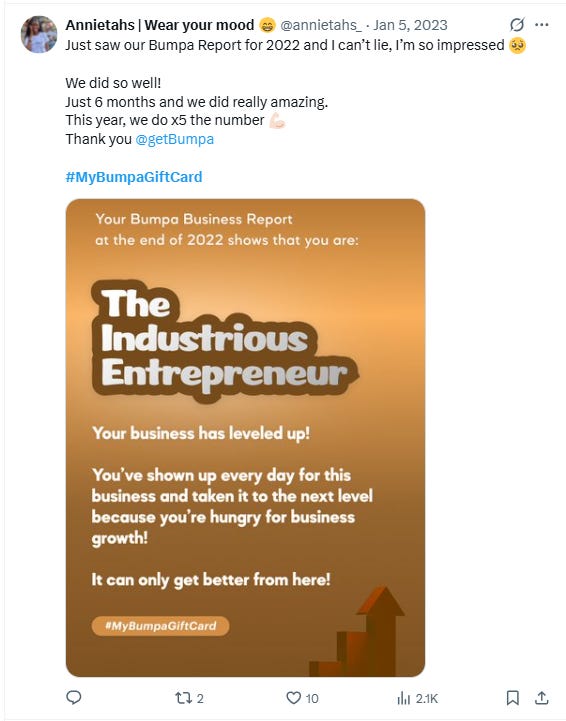
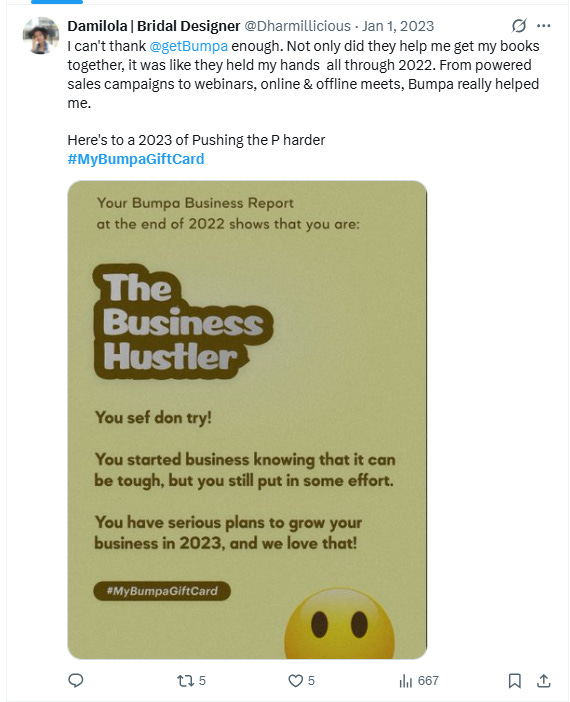
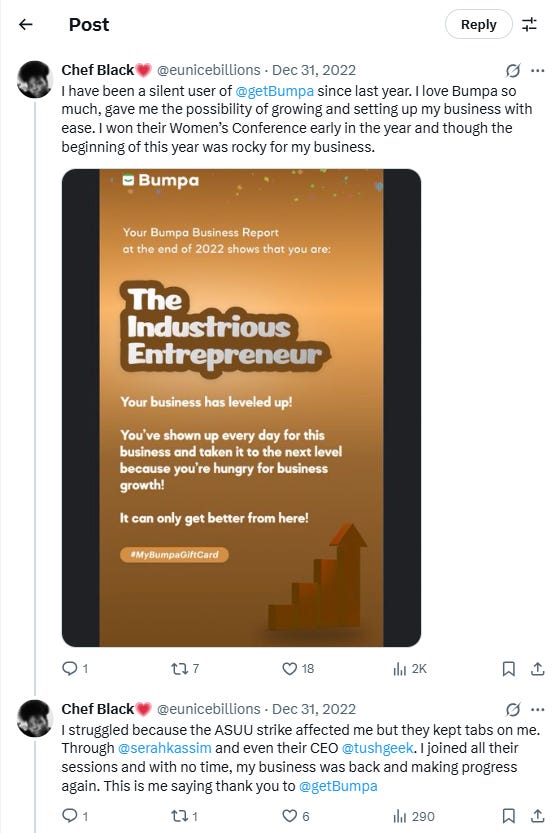
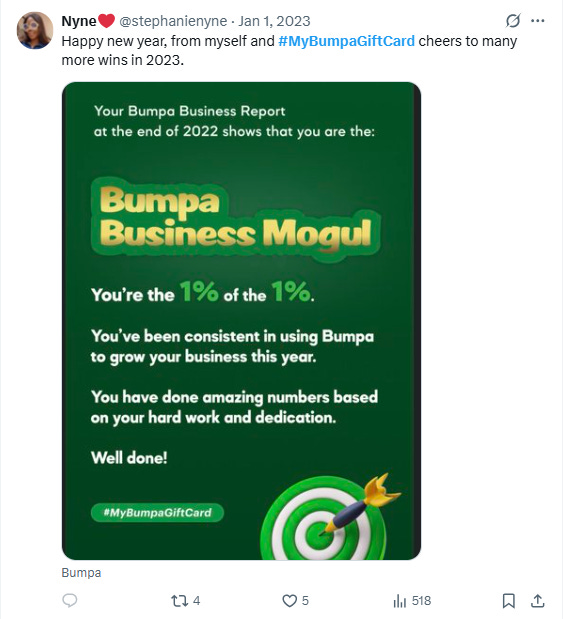
Now, Bumpa collects a lot more data points and shares the Wrapped via an in-app experience rather than email only.
Product Growth Management at Bumpa
Bumpa, like many all-in-one tools, contains multiple products within itself. So it only made sense for them to structure teams across products as they grew. Most of the product teams in Bumpa have product managers, engineers, product designers, and the occasional marketer.
Since Precious had already started doing some product management while she was a product marketer, it made perfect sense for her to join (and lead) a product team as well. But her team doesn’t have a separate product manager and marketer; they just have her. A Product Growth Manager.
Some people call this title a Growth PM -> A product manager who is focused on solving growth problems through product changes and experimentation. This is exactly what Precious does at Bumpa as well.
There is no better way for me to illustrate Product Growth Management at Bumpa than with a story Precious tells me about increasing adoption for Bumpa’s Campaign feature. She had previously shared this story on her Medium, but she does me the favour of telling it in more detail.
“There are some events that have transformed my career. What we call canon events. I’ve had maybe 5 of these in my career. This was one of them.”
Increasing Feature Adoption For Bumpa’s Campaign Feature
We have already established that Bumpa is a multifaceted product with many products within itself. One of those “products” is its Campaign feature. This feature lets business owners send emails & SMS to their customers.
It’s a great way for business owners to, for example, notify their customers about upcoming promotions. But it only had a 5% adoption rate -> only 5% of Bumpa users used it. And so the feature was assigned to Precious’ product team. Their task was to increase adoption.
Precious tells me that no one expected much from the feature—or from the task. Campaigns wasn’t a revenue maker compared to Bumpa’s other offerings. But Precious was determined to prove herself.
If a product marketer were presented with this problem, their approach might be to improve messaging and send more communications to users about the feature. But a Product Growth Manager isn’t limited to comms alone. So, the first thing Precious’ team did was to audit and fix the Campaigns feature.
Video snippet from my interview with Precious. She tells me how she and her team increased adoption for Bumpa’s Campaigns feature
Optimising the feature meant that its value to users improved significantly. So Precious decided to increase the pricing.
“We’d kept the SMS price the same since Bumpa first started. So I increased the price and created a tiered system where the price got cheaper the more units you bought. The goal was to encourage more purchases. On the outside, the product looked pretty much the same, but we’d made a lot of internal optimisations to make it a better product.”
After optimising the feature like a Product Growth Manager, Precious communicated it like a Product Marketer. She created workflows that notified users about the feature and nudged them to try it. She updated product articles to link back to the SMS feature. And she instructed customer-facing teams to tell users the feature was much improved.
“If you’ve been using the app for about a month, you enter a workflow system where you get a message like ‘hey did you know you can send an SMS?’ And when I created articles about how to run sales & promo on Bumpa, I’d mention that before you run the sale, you should send SMS or emails letting your customers know in advance. And I linked this back to the Campaign product.”
And it worked. Usage increased by 200%. Feature adoption went from 5% to 20%. Users were buying more SMS & email credits. Revenue from the feature increased by 100% month-on-month. Precious’ team had achieved this within a couple months with zero ad spend. They had exceeded expectations.
But then came a problem. They had gotten more attention, but it came at a cost. Users were sending messages to more customers than the team expected. Thousands of messages were getting sent out by users. They hadn’t planned on this much success. And so, the system got overwhelmed, and it began bleeding out of the Campaign feature and extending to the entire app.
The issues got to such a point that management decided to disable SMS temporarily. All of Precious’ team’s hard work was gone. Naturally, Precious says she felt “righteous anger.”
But after going through the 5 stages of grief, she understood the decision. Despite the increase in adoption, Campaigns still wasn’t Bumpa’s top feature or revenue driver. It wasn’t the core thing users came to Bumpa for, yet it was negatively impacting the experience with more important features. Precious and her team went back to the drawing board to question where they went wrong.
“I asked my technical lead: Did we overlook something? Why did this happen? Why do bad things happen to good people? He told me different jargon to reassure me. A month later, he sent me a tweet from a US PM who said we can try to retrace steps after things happen, but we have to also accept that some things just happen and there’s nothing you can do about it. If you build something to cater to 100,000 people and you get 1 million people, there’s no way you won’t have issues. And in the early stage, you won’t necessarily see what the infrastructure is like to cater to edge cases.”
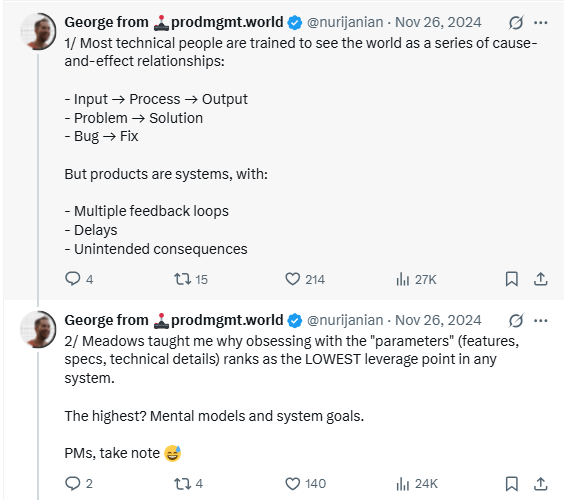
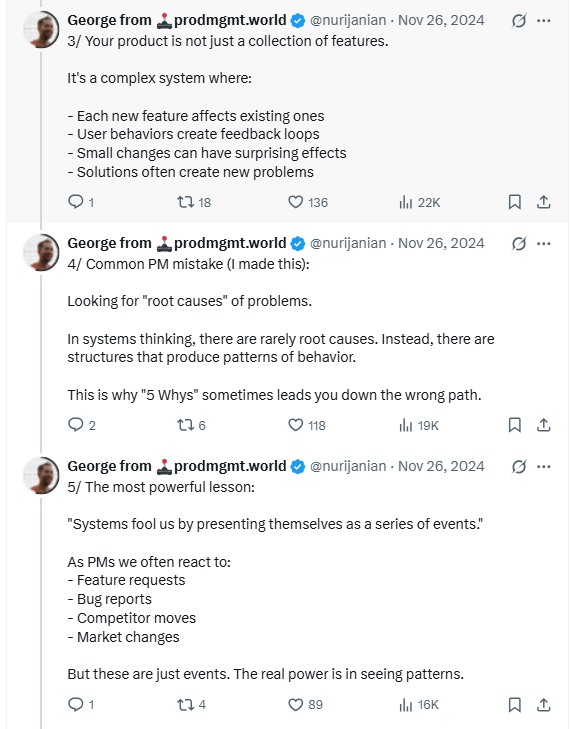
Despite it all, Precious is proud of the work her team did. It was one of the successes that was fully theirs. From ideation to optimisation to finding 3rd-party SMS providers and creating pricing systems for more revenue.
Today, the Campaigns feature is slowly being rolled back into Bumpa. Emails have been reactivated; SMS is set to come back in a few weeks.
Solving Onboarding Problems at Bumpa
The Campaigns feature isn’t the only thing Precious’ team worked on. One of their other major problems to solve was onboarding. To understand the onboarding problem, Precious explains that there are various contexts I need to understand.
The first context is that success for a Bumpa merchant could mean different things. For some, success is recording sales digitally so they don’t lose paper records. For some, it’s analytics, so they can see revenue, profit, and sales metrics easily. For others, it’s issuing invoices and receipts. But the most common use case for Bumpa users is to first get out a live e-commerce website. Because of this, having a live website is a key activation metric.
The second thing Precious explains to me is that Bumpa used to create websites for users by default. By this definition, one could say Bumpa’s activation was practically 100%. But that’s an incorrect definition, and Precious proves it by telling me customer stories.
“There were some people who were even on paid plans who said they didn’t know they had a website. Mind you, the website was right there in the app UI. It’s the first thing you see on the page; it’s in the email workflows. It wasn’t necessarily bad communication on our end, people can just be like that.”
The final thing you need to know is that Bumpa used to have reverse trials; where users were automatically placed on free trials upon sign up.
All of this background context is important, because Precious’ solution to Bumpa’s onboarding problem might seem antithetical or even counter-intuitive. But they all make perfect sense when you understand why.
There were 4 things Precious and her team did to improve onboarding completion at Bumpa. The first was the most obvious. The first solution to most onboarding completion problems is to reduce the length of the onboarding process. Precious and her team did this.
The second solution was almost as obvious as the 2nd. Precious’ team split user journeys based on their reason for signing up. They recognised that the website feature was the major value for most users, so that was a central track. But once they entered the product and had their website, onboarding became split into different tracks.
Now, for the antithetical solutions. We’ve established that website creation used to be automatic. From the outside looking in, that might seem like a perfectly seamless solution. But Precious knew better.
In 2011, researchers at Harvard coined a term called the IKEA Effect. It’s an aptly named cognitive bias where people place more value on things they invested effort into creating.
Precious’ 3rd solution was to force users to take certain actions before they could access their website. The IKEA Effect in action.
“Now, when you sign up, you have to do 4 things before we release your website. For example, you can’t see your website till you’ve added at least one product to your catalogue. You also need to add payment details so there’s no ‘where’s my money’ issues.”
Precious tells me this is an example of good friction. When most people hear about product friction, they assume it’s all bad. But some friction is good. Good friction refers to obstacles or resistance intentionally built in to increase perceived value, engagement, or long-term outcomes.
“People have to have the idea that they’re creating something [the website] by themselves. For those who didn’t know they had websites, it’s because they were never involved in making it. But now you have to make a bit of investment before you unlock it. So even though some people–who were not serious in the first place–dropped off and didn’t finish launching their websites, awareness for the feature skyrocketed.”
Precious is irrefutably right. This was good friction.
The final change that Precious’ team made was on the reverse trial. They reversed the reverse trial, going back to regular opt-in free trials. Precious explains why.
“One peculiarity with B2B SaaS is that people can create an account but not need you at the time. In e-commerce, it’s even worse. Users may have goods from China they’re waiting for. Or they may be waiting for edited product photographs. There are so many variables for businesses. So it was just a hunch at the time. I said ‘if we give these people free trial at a time when they don’t need the paid features yet, then it’s wasted on them’. They won’t see the value we’re trying to get them to see.”
If there were any doubt that Precious was right, the results cleared it up. When they started, onboarding completion was about 27%. When they were done, it had grown to 50%. More than that, they drastically reduced support queries about payment methods. Precious says she also no longer hears stories about users who don’t know they have websites.
Working with Engineers as a Non-Technical Person
It’s never easy to manage a team of people whose expertise you have limited knowledge of. Precious had started her career in content marketing, and now she was leading a team made up mostly of engineers. There was no way I’d let her off the call without asking her how she managed this.
Precious affirms that it’s not an easy thing, but shares the thinking frameworks & structures that help her make it seem so frictionless.
The first is that she tends to think in first principles and processes.
“If I’m not technical and I want to build a product, what do I do? I’ll explain the idea. What’s it supposed to solve? What is it going to do? It will probably not have the jargon, but I just need to explain exactly what I want. I ask about the consequences of doing what I want to do. I ask about the resources we need. I consider if the resources invested will be worth the results.”
The second thing feels like a natural continuation of the first. After Precious has defined her product requirements, her technical lead helps break down the technical requirements, implications, and barriers.
In Bumpa, the technical lead is the most senior engineer within a specific product team. They call out issues and think of technical implications—aka technical debt. All technical leads in Bumpa report to the head of engineering.
Sometimes, if she doesn’t understand what an engineer is saying, she goes to ask her technical lead. “This is what this person is saying. What can be done about it?” This helps her to catch engineers on their BS and keep accurate timelines.
The 3rd thing that helps Precious is that she is not afraid to look stupid to her team. When she doesn’t understand something, she asks her engineers to lay it out for her like she’s 5. Everyone needs help, she reasons. Even her devs.
“Even the engineer might not have all the answers. Sometimes they have to call a senior dev who has worked on a similar product to ask for advice. One time, I was implementing something with an engineer but he was finding it difficult to implement. We brought someone else in for advice and he brought a resource we hadn’t looked at before. We looked at it and were able to implement. So if engineers themselves need help, why won’t I?”
Everyone is learning together on the job, she says. So why should she be afraid to show she’s learning too? She simply asks questions and goes to do her research.
The final thing is that Precious knows her team. She has been with Bumpa for years. Her developers feel like her guys. She refers to them this way on the call. She speaks about them almost like rambunctious siblings who she can call out, fight, and speak freely with.
Long Stay At Bumpa
Precious has been at Bumpa for over 4 years. She was there when they only had about 100 users. She’s there now that they have 100,000 users. And she has played a big part in that growth.
I ask her the secret for her long stay. What does Bumpa do to keep her tied to them?
Two things, she says. The first is that she works with “truly brilliant, amazing people”. One less-discussed HR truth is that top talent prefers to work with top talent. In fact, amazing employees will only really thrive when they work with other brilliant people. This appears to be Bumpa’s secret.
It is also clear that Precious likes her colleagues. In a previous article, Precious has said she doesn’t think of work as family. During her call, she indicates—both directly and indirectly—that she does now, to some extent. Work is still work (your family can’t sack you), but you can build meaningful relationships that extend past work alone.

Precious speaks of her colleagues fondly and says they are bonded, not by work alone, but by the personal milestones they’ve witnessed. Over the past 4 years, she has attended their weddings and naming ceremonies. They’ve shared both joyful and painful moments. When you spend 8 hours a day & 5 days a week for 4 years with a group of people, you are bound to become attached to them.
The second reason for Precious’ long stay is far less emotional. She might love her colleagues, but she loves her career too. So, Bumpa lets her go on what she calls “transfer windows” to aid her career and give her more varied experiences. She is honest with Bumpa’s CEO about moments when her job satisfaction decreases, and they find a workaround to fix things.
A third reason that Precious doesn’t directly tell me, but that I suspect, is that she receives fulfilment from seeing the work of her hands directly improve people’s lives. Throughout our interview, she shares various stories about how Bumpa has impacted customers and the excitement she has felt on receiving feedback. She doesn’t need to tell me; when I search “Bumpa” on Twitter, I see raving reviews.
There you have it. A look at how Bumpa grew to 100,000 users; and how they sustain and expand that growth.
You can find Precious on LinkedIn or Twitter.
📣Tweet this.
Did you reading this? Give it a ❤️ and let me know in the comments section.
Even better, share this with someone. If they subscribe, you get referral rewards, like free templates.
Want to do more than read MFG?
Join MFG’s WhatsApp community to partake in marketing discussions. The community includes 500+ Nigerian marketers across all levels sharing ideas, feedback, and resources.
Take advantage of discounts from MFG’s partners
Treford’s live bootcamps - 15% discount - Code MFG
Algrowithm's growth engineering trainings - 15% discount - Code MFG
The Growth Handbook by Binjo Adeniran - 20% discount - Code MFG
Contribute guest posts to MFG. Works best if you’re looking to build bylines for your portfolio.
If you’re a B2B SaaS founder in need of product marketing support, let’s talk. Book a discovery call to discuss how I can help.
What I’m Reading
The 13 viral marketing laws — 13 laws & principles to help you hack virality.
40 things we’ve learned about marketing for developers — Lessons from PostHog about brand, content, paid ads, SEO, LLMs, and more.
How 150+ Creators and 600 TikToks Per Month Become an Acquisition Engine — Great read for anyone interested in TikTok marketing.
The MKT1 Field Guide to B2B startup marketing | Part 1 — High-level marketing frameworks to help you think about strategy.
5 Rules to win on LinkedIn in 2025 — Great read for anyone trying to stand out on LinkedIn
https://techcabal.com/2022/09/19/what-to-expect-from-the-social-commerce-session-at-the-future-of-commerce-2022/




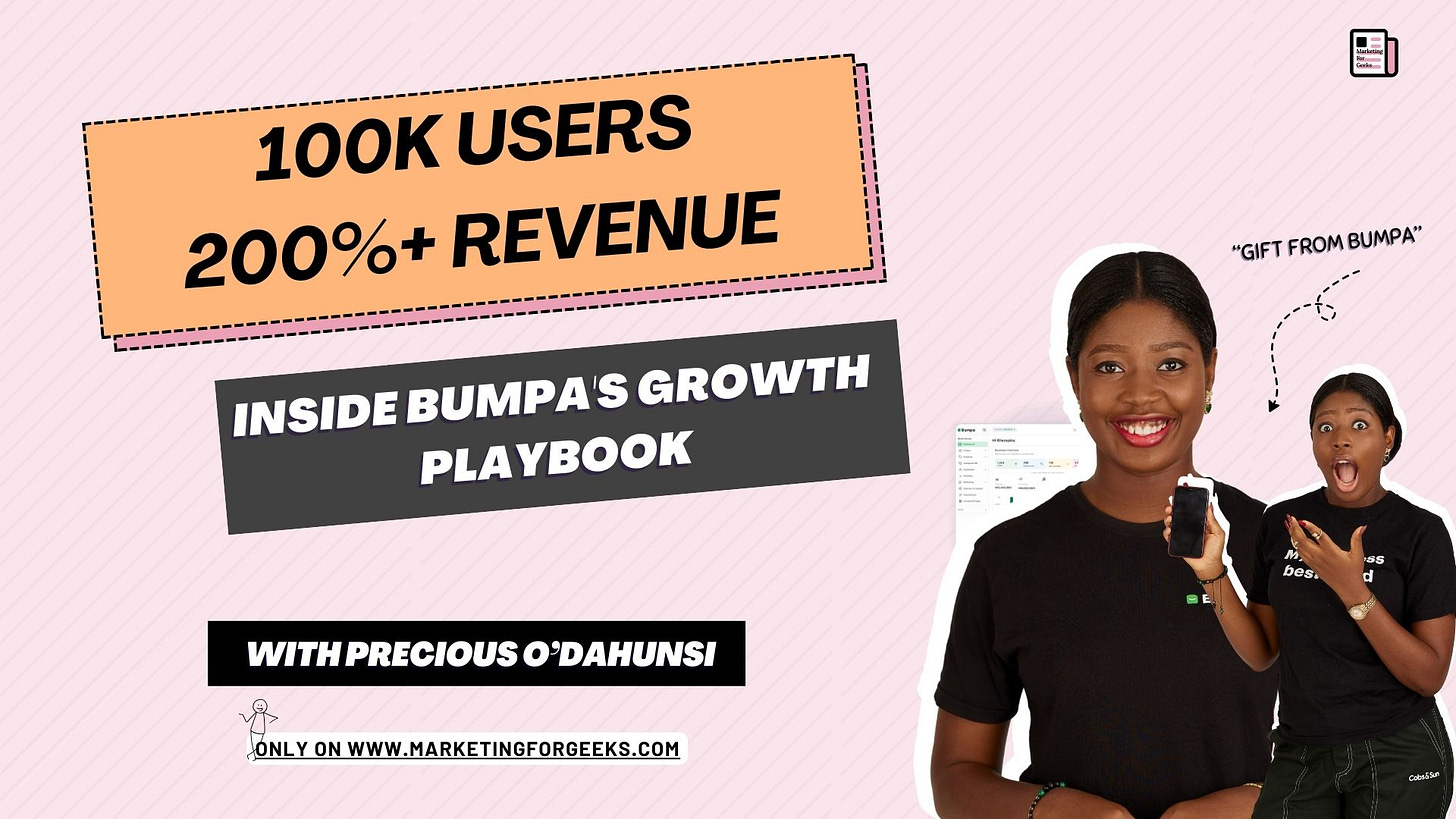

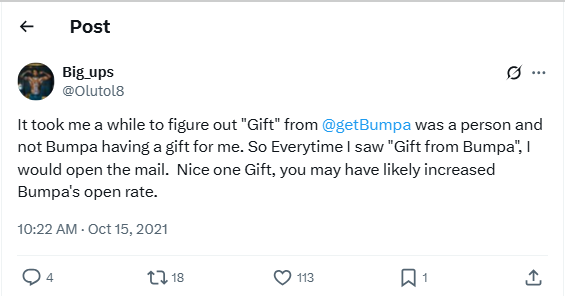
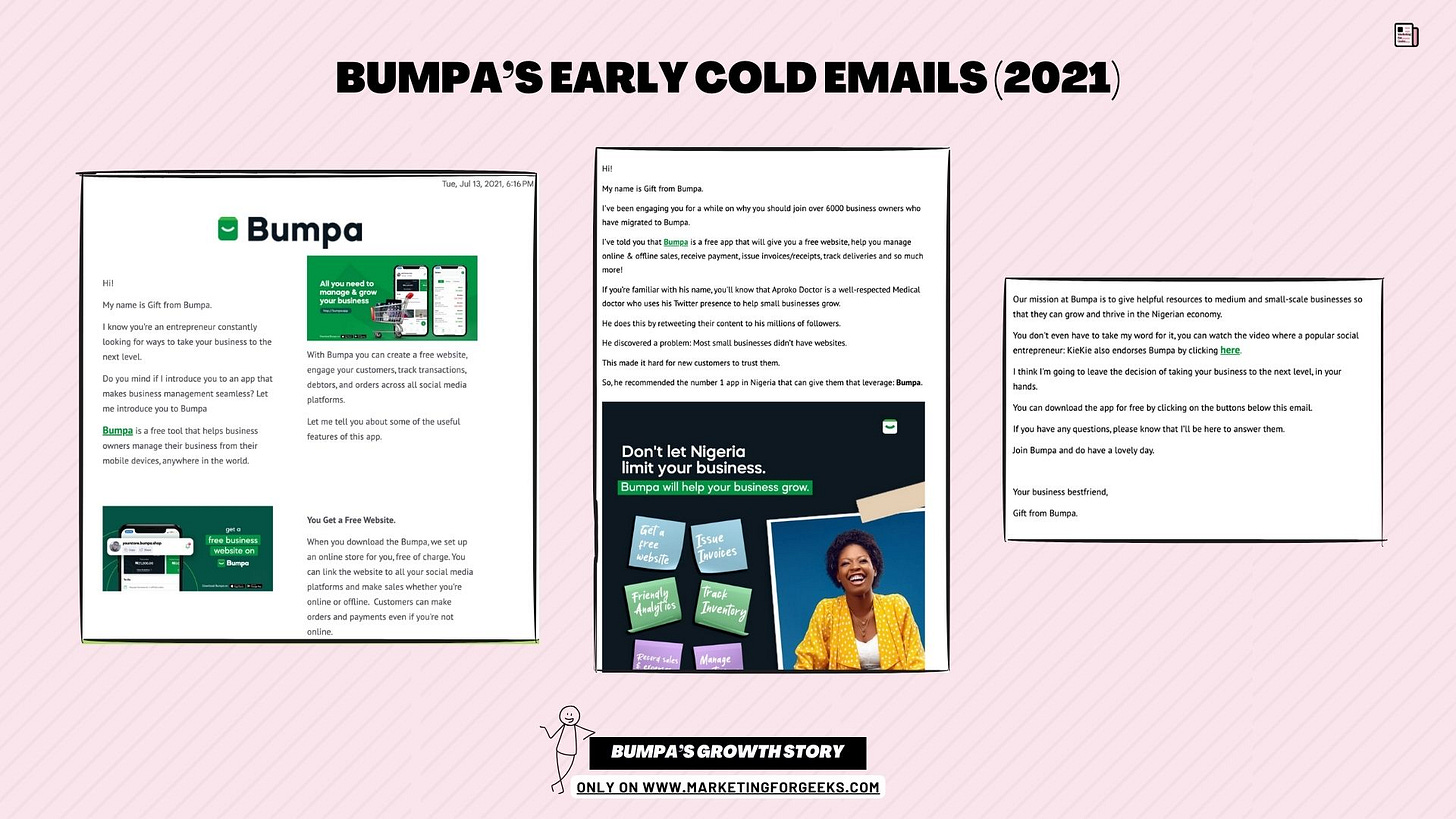

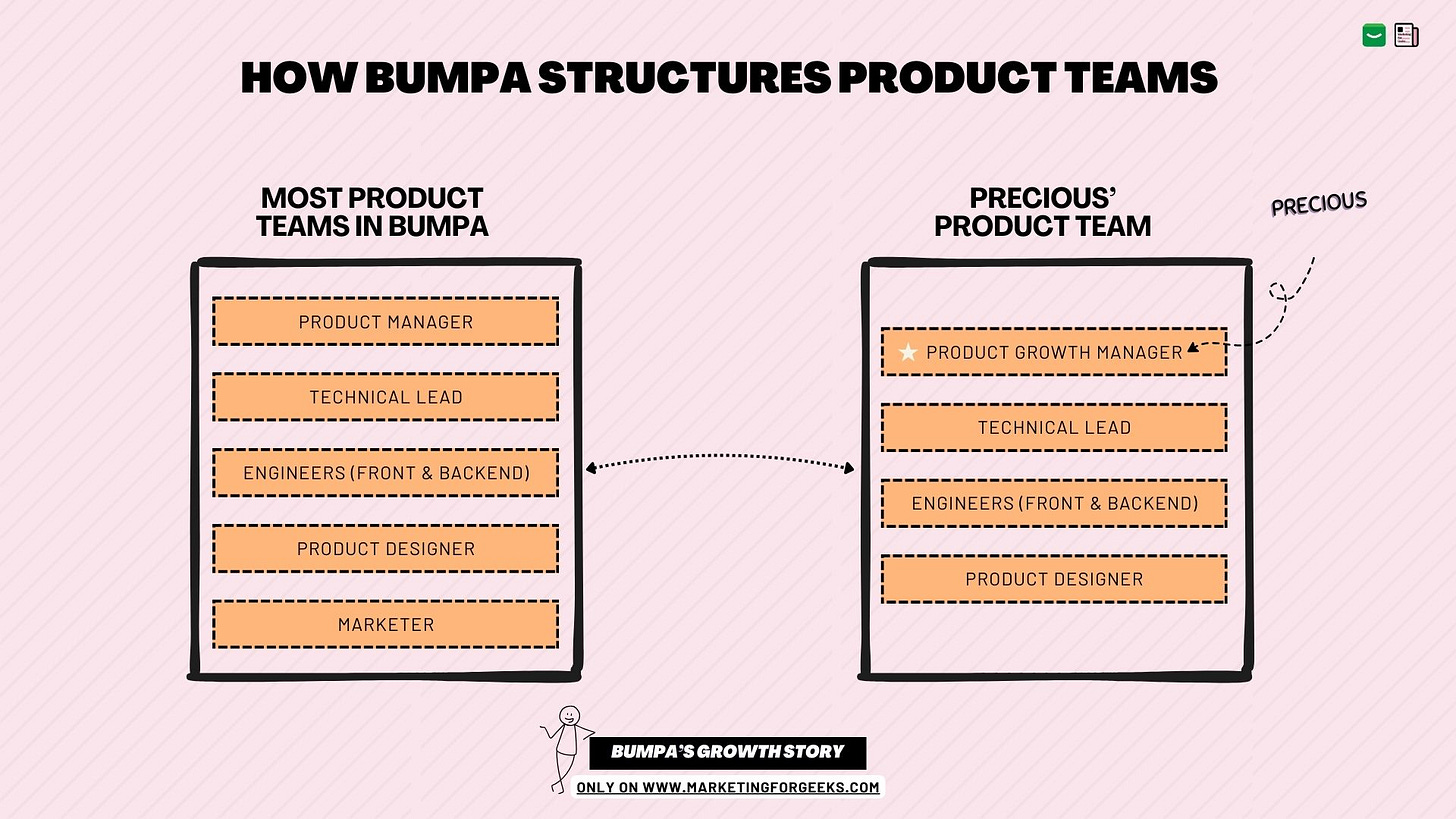





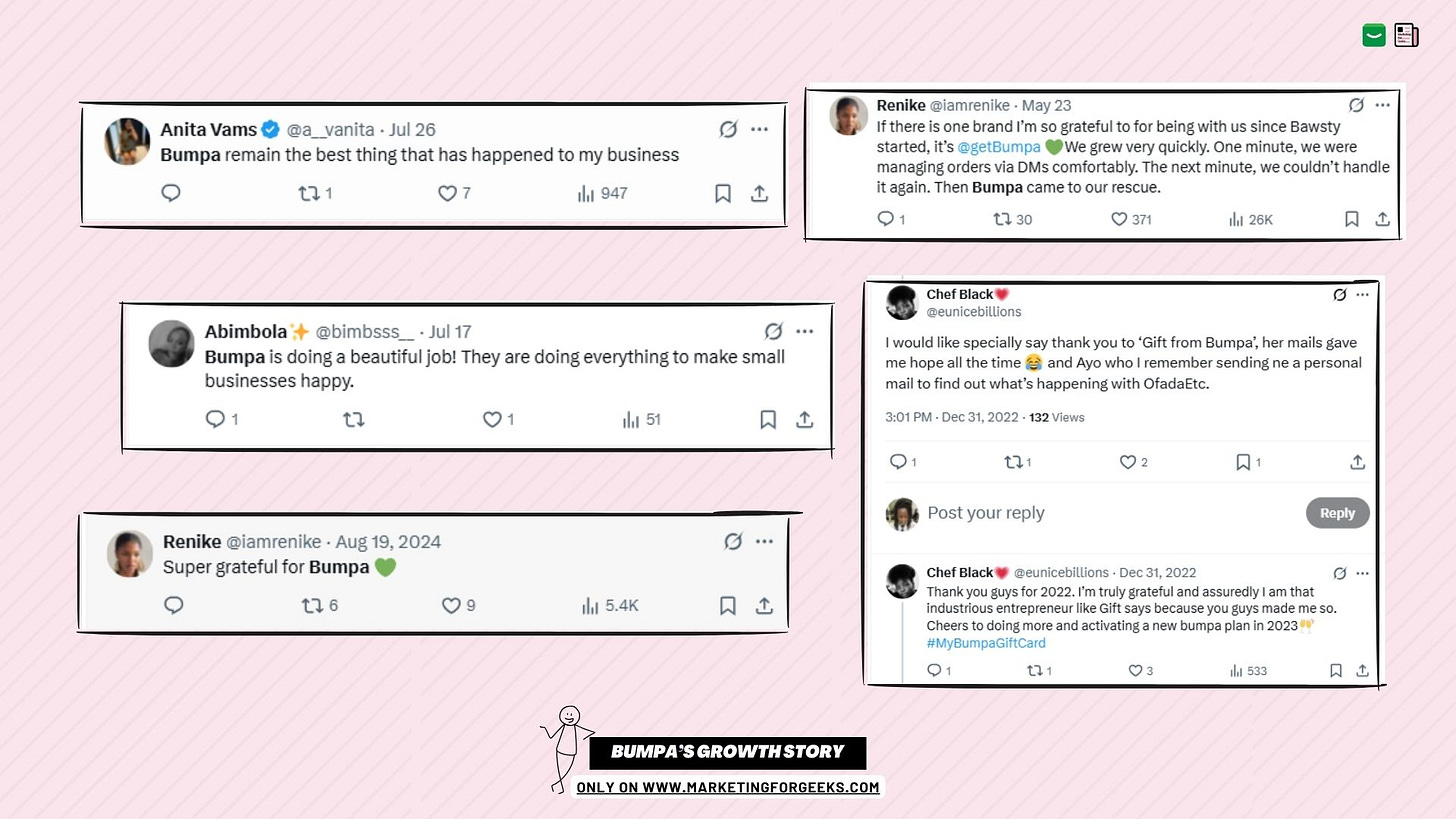

I enjoyed reading this.✨🙂↔
I reallyyyyy enjoyed reading this. Thank you!